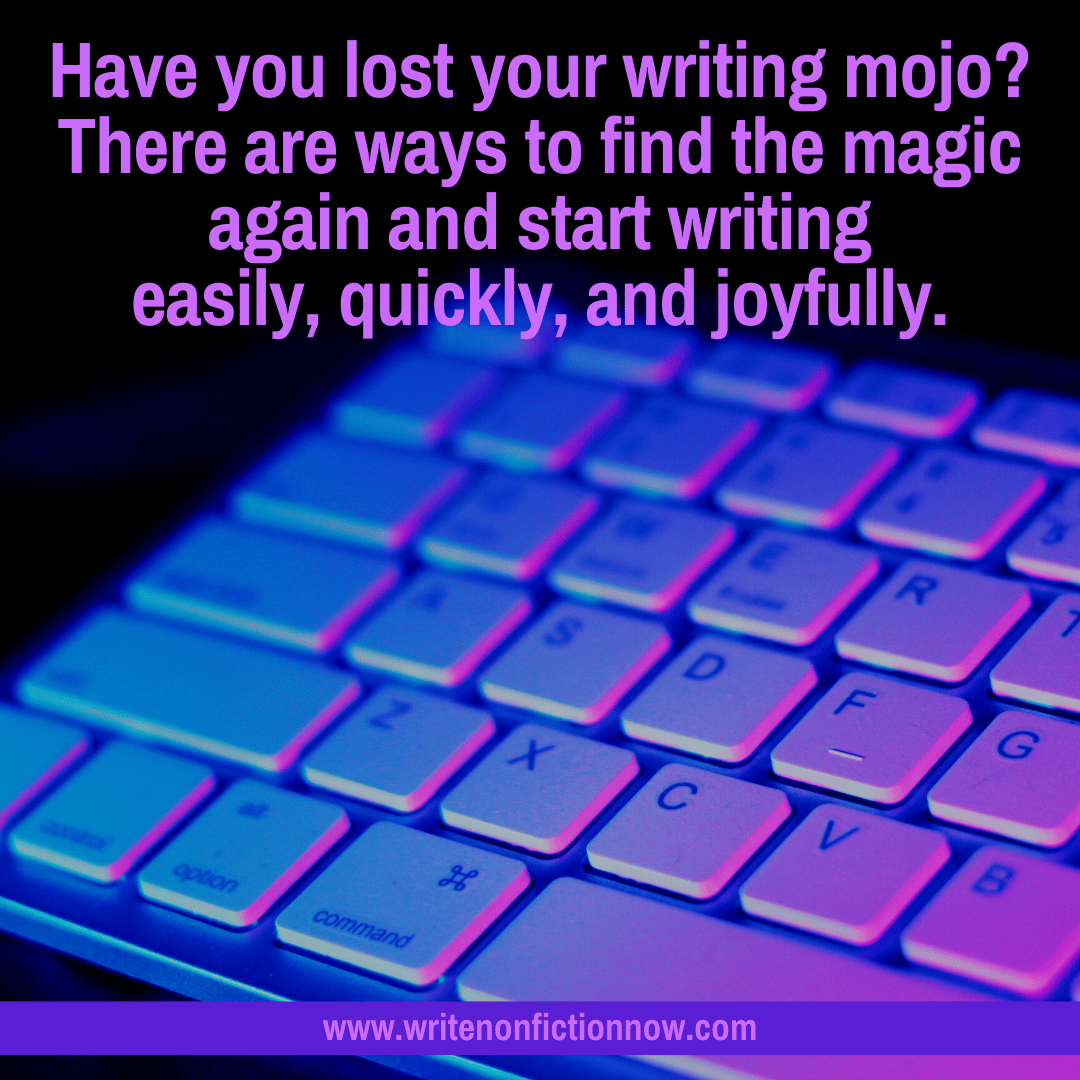Thursday, June 2, 2022

Have you ever lost your writing mojo? You aren’t alone, but you can find the magic again and start writing easily, quickly, and joyfully in no time.
How do I know? Because I lost my mojo for a while, but I found it again.
Where Did You Lose Your Writing Mojo?
Losing your writing mojo seems to happen when you least expect it, seemingly without reason. One day you are writing as usual, and the next, you can’t get a complete sentence together. The reason for this predicament can feel a bit like a mystery.
Like most of us—me included, you will want to know why you lost your mojo. But the reason really doesn’t matter.
The reason(s) for losing your writing mojo actually is much less important than the ways to find it. I know you want to understand what happened, maybe so you can avoid having the same problem in the future. Or you might simply want to place blame—“It’s so-and-so’s fault that I have writer’s block!”
Believe me…I get it (especially the blame part). But in the end, the only thing that matters is that you regain your writing mojo. Then, if it disappears in the future, you’ll know how to bring it back like a magician producing a rabbit out of a hat.
10 Ways to Get Back Your Writing Mojo
The following ten strategies helped me get my mojo back when I felt writing was hard…so hard that I didn’t bother to try writing for quite some time.
But writers write, right?
And I’m a writer. So, I knew I needed to find my mojo.
I tried a lot of different tricks, tactics, and tips. However, the following ones helped me most, and I hope they’ll work for you.
1. Stand up.
Most writers work sitting down, which doesn’t promote deep breathing or good circulation. That means your body—including your brain—doesn’t get the oxygen or blood it needs. When you stand while writing instead, you allow yourself to breathe fully. As a result, you will feel more creative and clear-headed. You also might feel more motivated, especially if you don’t allow yourself to sit until you finish a specific number of words or pages. Find a place in your home to use your laptop that is the correct height for typing. Or purchase a portable standing desk or a desktop that goes up and down. (I have both.)
2. Be accountable.
It’s incredible how we typically lack accountability with ourselves but not others. So, if you are struggling to keep your word to yourself, give it to someone else instead. Every morning tell your accountability buddy what you intend to accomplish. Then report back to them daily (not weekly). You’ll be amazed at how much you get done when you have a “deadline” and someone expecting to receive your work—or at least an honest report that you did it. (This person does not have to be another writer.)
3. Move your body.
Sitting is sedentary and not conducive to creativity. Again, your brain needs oxygen, and sitting promotes shallow breathing. So, if you don’t want to stand and write, move your body before you begin a writing period. Exercise, dance, do yoga or tai chi, take a walk, or skip around your house. Anything that feels good or gets your heart pumping works.
4. Change your energy.
Energy is everything! And that’s why you need it to write. If you’ve lost your writing mojo, you likely show up at your computer feeling depressed, anxious, defeated, or angry. It’s hard to write when you feel negative emotions because they lower your energy. Therefore, it’s imperative to raise your energy before you attempt to write. Watch funny Facebook or Instagram stories. Go out in nature. Play with the dog or pet the cat. Call a friend who can be your cheerleader. View motivational or inspirational YouTube videos. As mentioned above, you can also move your body; exercise is a great energy enhancer! Then, when you are feeling upbeat and energized, try writing.
5. Play music.
Music is the great healer. It is also an energy and mood enhancer (as long as you don’t listen to songs about something depressing). Some people, like myself, like to listen to music meant to increase focus. Others want to listen to their favorite artists—rock, jazz, classical, blues…whatever! So if you usually try to write in silence, turn on your favorite music tracks. Then, see if that doesn’t help you get your mojo back.
6. Use visualization.
Visualization, active daydreaming, and self-hypnosis are fabulous ways to program your brain to write quickly and effortlessly. So, if you want to get your writing mojo back, try one of them. An easy breathing technique, like 7–11 breathing, will put you in a relaxed state conducive for these exercises. Then simply imagine yourself writing. Then, using your mind’s eye, visualize what it would feel and be like to have your writing mojo back—mentally experience being in the writing flow. Finally, imagine yourself six months into the future; what results would you achieve by writing quickly and effortlessly by that point? Do this two or three times per day for a month…or longer, and you will have reprogrammed your brain to get in the writing flow.
7. Remember your “why.”
Most nonfiction writers write because they have a strong sense of purpose. They want to make a difference or be of service. They may even have a cause of movement to promote. You will be more likely to write when you keep your purpose forefront in your mind. After all, someone needs your book, article, or blog post. And you fulfill your purpose by giving them what they need. Getting clarity on your purpose as a writer will fuel your writing and add a big of necessity and urgency to the mix, which will get your fingers on the keyboard.
8. Get tapped in.
One of my favorite strategies is to call on your “spirit team” or a higher power to help me write. (Yes, really.) Many writers believe God, spirit guides, ancestors, or angels help them write by providing information, wisdom, inspiration, or guidance. If you are one of those people, invoke your spirit team before beginning a writing session. Ask for guidance and for your writing blocks to be removed. You might add in a bit of meditation or a ritual. Then pull out your laptop and write.
9. Change your identity.
As I said before, writers write. So be a writer. If you take on the identity of a writer, you will do what writers do…write. That will be your habit, and you’ll form it naturally because it will align with your identity. To have a completed (and published) writing project, you must first be a person who can do what writers do—write. So tell yourself daily that you are a writer. Then show up as a writer every day.
10. Do the thing.
All that’s left is for you to do “the thing”…write. Sometimes, that’s what it takes. Don’t wait for motivation or inspiration or for your writer’s block to suddenly disappear. Just write. Even when it’s hard, write. Even when you don’t think you have anything to say, write. Even with the writing is horrible, write. Write every day at the same time…no matter what. No excuses. Just write, and your mojo will return.
Focus on What You Want
Last but not least, don’t keep telling yourself you’ve lost your writing mojo. Stop focusing on what you don’t have…and don’t want. Instead, focus on what you want—to be in the writing flow.
Whenever you find yourself bemoaning that you aren’t writing as easily or joyously as you’d like, turn your mind to a time when you did. Remember yourself writing magically. And tell yourself over and over again, “I am a writer, and writing comes easily and effortless to me.”
If you ever lost your writing mojo, tell me how you got it back. And please share this post with someone who is feeling challenged to write. And if you need some support getting it back,
.
 Would you like to write and publish nonfiction work, like articles, blog posts, books, or reports…and become a successful author? Join the Nonfiction Writers’ University. Get the basic education you need and the group Author Coaching to help you succeed as a nonfiction writer.
Would you like to write and publish nonfiction work, like articles, blog posts, books, or reports…and become a successful author? Join the Nonfiction Writers’ University. Get the basic education you need and the group Author Coaching to help you succeed as a nonfiction writer.
Enjoy a 30-day trial membership for only $1. If you’ve felt the desire to get coached and be supported as you pursue authorship, this program is for you. Participate in monthly group Author Coaching sessions and gain access to an extensive archive of writing and publishing resources.
Photo courtesy of evgenyatamanenko.
Nina Amir, the bestselling author of How to Blog a Book and The Author Training Manual, is a speaker, a blogger, and an author, book, blog-to-book, and high-performance coach. Known as the Inspiration to Creation Coach, she helps creative people combine their passion and purpose so they move from idea to inspired action and positively and meaningfully impact the world as writers, bloggers, authorpreneurs, and blogpreneurs. Some of Nina’s clients have sold 300,000+ copies of their books, landed deals with major publishing houses and created thriving businesses around their books. She is the founder of National Nonfiction Writing Month, National Book Blogging Month, and the Nonfiction Writers’ University. As a hybrid author she has published 19 books and had as many as four books on the Amazon Top 100 list at the same time. Her most recent book is called Creative Visualization for Writers, and tomorrow her 19th book will be released, The Write Nonfiction NOW! Guide to Creativity and Flow. Find all her books at booksbyninaamir.com or find out more about her at ninaamir.com.